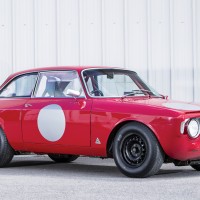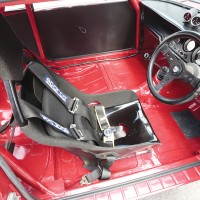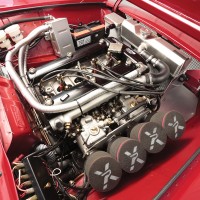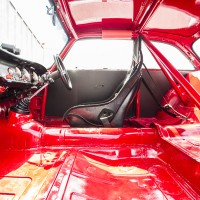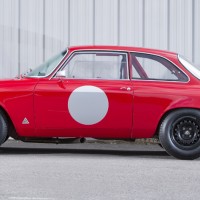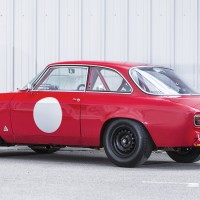SCM Analysis
Detailing
| Vehicle: | 1965 Alfa Romeo Giulia Sprint GTA |
| Years Produced: | 1965–67 |
| Number Produced: | 1,000 (estimated) |
| Original List Price: | $5,625 |
| SCM Valuation: | $165,000–$325,000 |
| Chassis Number Location: | Next to Distributor |
| Engine Number Location: | On the firewall |
| Club Info: | Alfa Romeo Owners Club USA |
| Website: | http://www.aroc-usa.org |
| Alternatives: | 1960–65 OSCA 1600 GT, 1964–65 Porsche 911 2.0, 1965–67 Alfa Romeo Giulia GTA Stradale |
| Investment Grade: | A |
This car, Lot 264, sold for $275,145, including buyer’s premium, at Bonhams’ Goodwood Revival Auction on September 14, 2014.
In early 1965, the first prototype GTAs appeared, pre-homologation, racing first at Monza in April (although both cars failed to finish). But by July 1965, it was successfully homologated into Group 2, and more and more cars started to appear — and win.
Based on the Guilia GT production car, Alfa leveraged the growing expertise and success of their Autodelta racing subsidiary to create a lightweight touring car to go head-to-head with a growing number of manufacturers who saw an opportunity to turn sedan car racing into a more competitive, professional kind of racing. The goal — after winning — was selling more of their marque’s product.
The beginnings of the GTA were actually years earlier, in 1962, when the Giulia replaced the already popular Giulietta line. The Giulia, also called the Series 105, was graced with beautiful lines thanks to the house of Bertone.
Alfa called on Autodelta’s Chiti and Chizzola to create a racing version of the Giulia Sprint GT, and focusing on the twin pillars of racing — more power and less weight — the GTA was born.
The GTAs came in two models, Stradale (road) and Corsa (racing), and cars coming from Autodelta came with a high premium, as the racing modifications cost almost what the original car cost. Autodelta was reluctant to give a GTA to someone without a racing pedigree, at least initially.
A lightweight with muscle
Power came from the DOHC four with four valves per cylinder, modified valve angle and double spark plugs in each hole, with plenty of spark coming from the Marelli distributor found in the Ferrari Dino.
Add 45-mm carburetors instead of 40 mm, and horsepower numbers soared from the stock configuration. There was lightening in the engine bay, coming from a magnesium camshaft cover, sump, timing cover and bell housing.
The GTA had alloy body panels replacing the stock steel (the alloy was called Peraluman 25, if you feel the need to impress at the next Cars & Coffee), and the lighter panels were pop-riveted to the regular steel structure (even the inner steel panels were produced out of thinner gauge). The pop rivets on the roof are quite visible behind the drip rail, and often a few are loose, as the steel and aluminum alloy react to each other. Even the passenger’s floor was replaced with the lightweight Peraluman 25 for some cars, but the practice evidently was dropped due to structural rigidity loss and compromised handling. The Peraluman 25 floor later returned in racing as stronger roll cages came into vogue. The factory cars had extensive replacement of everything from package shelves to dashes to seat backs — all in the lightweight alloy.
Suspension changes included an aluminum rear upper control arm, and a sliding-block rear axle locating system, although not much was done to lighten bits in the front suspension.
The engine changes raised the grunt levels to nearly 170 horsepower, with top speed breaking through 135 miles per hour. Yeah, a GTA is that kind of fun.
The factory cars were better
According to Tony Adriaensens’ exhaustive history of the car, Alleggerita, the exact number of GTAs produced for homologation is still up in the air. This car, AR753621, appears to be one of 147 RHD models delivered and was probably built late in 1965.
With so much weight taken out of the car (more than 440 pounds), you wound up with a 1,630-pound sedan with a great suspension, a low center of gravity and predictable handling.
All this added up to a quite successful race car, on both sides of the Atlantic.
The factory Autodelta cars were clearly superior to the customer cars when they came to Sebring in 1966, which led American race teams to start over. They ripped off the Autodelta badges and went through the cars from engine to taillights to find more speed. That speed turned a Trans-Am championship the first year.
Race, tour — or both
The GTA was a remarkable touring car, and the one on sale at Bonhams, while short on racing history, is a good example and is ready to go vintage racing on either side of the pond, as it also sports all the right papers.
While our car appears to be a homologation car, the rarity of good existing examples makes it a good buy at $275,145, which is right in the middle of the SCM Pocket Price Guide range of $165,000–$325,000.
It’s a great tool, ready to use, as well as grow in value. ♦
(Introductory description courtesy of Bonhams.)
